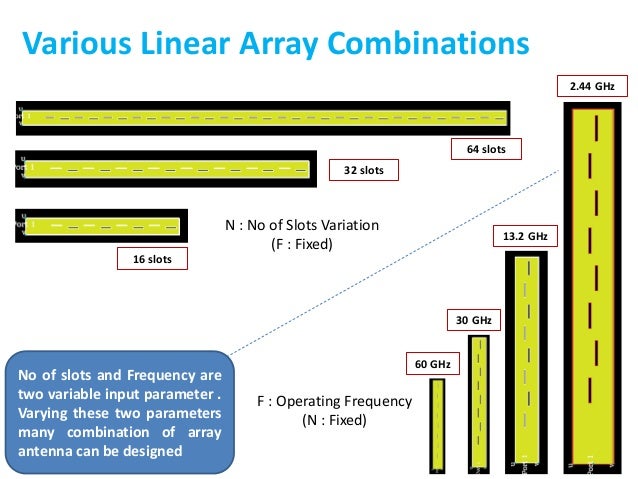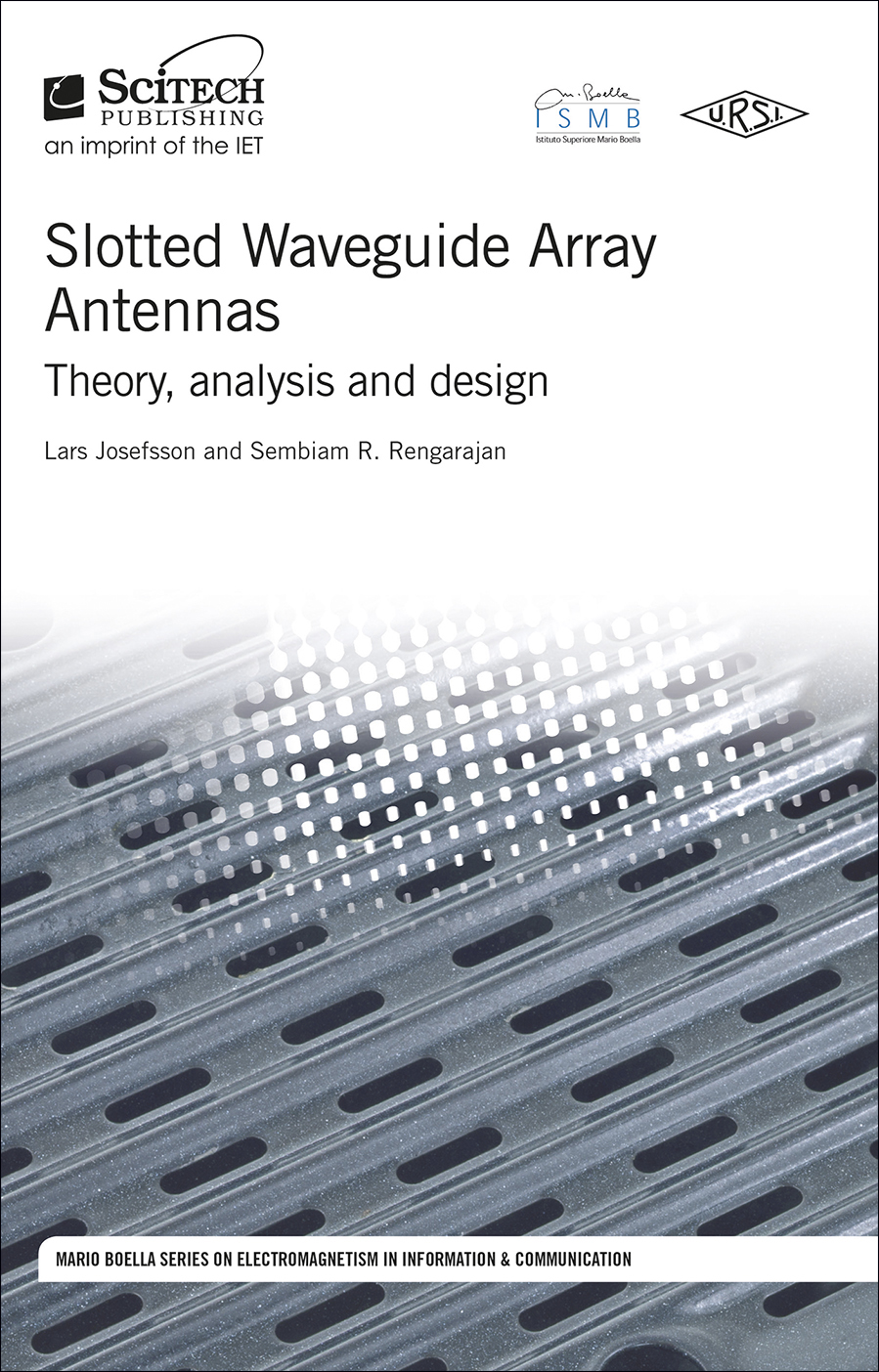Waveguide Slot Array Antenna Design
- Waveguide Slot Array Antenna Design Calculator
- Waveguide-slot Array Antenna Designs For Low-average-sidelobe Specifications
- Elliott RS (1983) An improved design procedure for small arrays of shunt slots. IEEE Trans Antennas Propag 31:48–53CrossRefGoogle Scholar
- Elliott RS, Kurtz LA (1978) The design of small slot arrays. IEEE Trans Antennas Propag 26:214–219CrossRefGoogle Scholar
- Josefsson LG (1987) Analysis of longitudinal slots in rectangular waveguide. IEEE Trans Antennas Propag 35:1351–1357CrossRefGoogle Scholar
- Khac TV, Carson CT (1973) Impedance properties of a longitudinal slot antenna in the broad face of a rectangular waveguide. IEEE Trans Antennas Propag 21:708–710CrossRefGoogle Scholar
- Kurtz LA, Yee JS (1957) Second-order beams of two-dimensional slot arrays. IRE Trans Antennas Propag 5:356–362CrossRefGoogle Scholar
- Lyon RW, Sangster AJ (1981) Efficient moment method analysis of radiating slots in a thick-walled rectangular waveguide. IEE Proc 128(pt.H):197–205Google Scholar
- Maxum BJ (1960) Resonant slots with independent control of amplitude and phase. IRE Trans Antennas Propag 8:383–388CrossRefGoogle Scholar
- Oliner AA (1957) The impedance properties of narrow radiating slots in the broad wall of rectangular waveguide. IRE Trans Antennas Propag 5:1–20CrossRefGoogle Scholar
- Park SH, Hirokawa J, Ando M (2003) Simple analysis of a slot with a reflection-canceling post in a rectangular waveguide using only the axial uniform currents on the post surface. IEICE Trans Commun 86(8):2482–2487Google Scholar
- Rangarajan SR (1989) Compound radiating slots in a broad wall of a rectangular waveguide. IEEE Trans Antennas Propag 37:1116–1123CrossRefGoogle Scholar
- Sakakibara K, Hirokawa J, Ando M, Goto N (1994) A linearly-polarized slotted waveguide array using reflection-canceling slot pairs. IEICE Trans Commun 77:511–518Google Scholar
- Sakakibara K, Hirokawa J, Ando M, Goto N (1996) Periodic boundary condition for evaluation of external mutual coupling in a slotted waveguide arrays. IEICE Trans Commun 79:1156–1164Google Scholar
- Sakakibara K, Kimura Y, Akiyama A, Hirokawa J, Ando M, Goto N (1997) Alternating phase-fed waveguide slot arrays with a single-layer multiple-way power divider. IEE Proc Microw Antennas Propag 144:425–430CrossRefGoogle Scholar
- Seki H, Goto N (1981) Synthesis of circular polarization with non resonant slots in the narrow wall of a rectangular waveguide. Trans IECE 64(pt.B):1000–1007Google Scholar
- Stegen RJ (1971) Longitudinal shunt slot characteristics, Technical report 261, Hughes technical memorandumGoogle Scholar
- Stern GJ, Elliott RS (1985) Resonant length of longitudinal slots and validity of circuit representation: theory and experiment. IEEE Trans Antennas Propag 33:1264–1271CrossRefGoogle Scholar
- Stevenson AF (1948) Theory of slots in rectangular waveguides. J Appl Phys 19:24–38MathSciNetCrossRefGoogle Scholar
- Watson WH (1946) Resonant slots. IEE J 93(pt.3A):747–777Google Scholar
- Watson WH (1947) The physical principles of wave guide transmission and antenna system. Oxford University PressGoogle Scholar
- Yee HY (1974) Impedance of a narrow longitudinal shunt slot in a slotted waveguide array. IEEE Trans Antennas Propag 22:589–592CrossRefGoogle Scholar
- Zhang M, Hirokawa J, Ando M (2011) Full-wave design considering slot admittance in 2-D waveguide slot arrays with perfect input matching. IEICE Trans Commun 94:725–734CrossRefGoogle Scholar
- The array design is modular (with four sym- metric modules) to ease fabrication and to maximize transportability and repairability A rectangular waveguide corporate-feed network is used to minimize.
- This is the first comprehensive treatment of slotted waveguide array antennas from an engineering perspective. It provides readers with a thorough foundation in applicable theories as well as hands-on instruction for practical analysis and design of important types of waveguide slot arrays.' Slotted Waveguide Array Antennas' goes beyond some of the commonly discussed topics and ventures into.
- A planar slotted waveguide array antenna has been designed at 9.37 GHz for X-band radar applications. The antenna consists of multiple branchline waveguides with broadwall radiating shunt slots.
Slot Antenna
Figure 1: The length of a slot determines the resonant frequency, the width of the slit determines the broad bandwidth of the slot radiator.
Slotted antenna arrays used with waveguides are a popular antenna in navigation, radar and other high-frequency systems. They are simple to fabricate, have low-loss (high antenna efficiency) and radiate.
Figure 1: The length of a slot determines the resonant frequency, the width of the slit determines the broad bandwidth of the slot radiator.
Slot Antenna
Slot radiators orslot antennas are antennas that are used in the frequency range from about 300 MHz to 25 GHz. They are often used in navigation radar usually as an array fed by a waveguide. But also older large phased array antennas used the principle because the slot radiators are a very inexpensive way for frequency scanning arrays. Slot antennas are an about λ/2 elongated slot, cut in a conductive plate (Consider an infinite conducting sheet), and excited in the center. This slot behaves according to Babinet's principle as resonant radiator. Jacques Babinet (1794 - 1872) was a French physicist and mathematician, formulated the theorem that similar diffraction patterns are produced by two complementary screens (Babinet's principle). This principle relates the radiated fields and impedance of an aperture or slot antenna to that of the field of a dipole antenna. The polarization of a slot antenna is linear. The fields of the slot antenna are almost the same as the dipole antenna, but the field’s components are interchanged: a vertical slot has got an horizontal electric field; and the vertical dipole has got a vertical electrical field.
The impedance of the slot antenna (Zs) is related to the impedance of its complementary dipole antenna (Zd) by the relation:
| Zd · Zs = η2/4 | where | Zs = impedance of the slot antenna Zd = impedance of its dual antenna η = intrinsic impedance of free space. | (1) |
It follows for Zs = 485 Ω.
The band width of a narrow rectangular slot is equal to that of the related dipole, and is equal to half the bandwidth of a cylindrical dipole with a diameter equal to the slot width. Figure 2 shows slot antennas different from the rectangular shape that increasing the bandwidth of the slot antenna.
Figure 2: Various broadband slot antenna.
Although the theory requires an infinite spread conductive surface, the deviation from the theoretical value is small when the surface is greater than the square of the wavelength. The feeding of the slot antenna can be done with ordinary two-wire line. The impedance is dependent on the feeding point, as in a dipole. The value of 485 Ω applies only to a feeding point at the center. A shift of the feed point from the center to the edge steadily decreases the impedance.
The application of slot antennas can be versatile. They can replace dipoles e.g. if it is required a polarization perpendicular to the longitudinal extension of the radiator. If a dipole is used for feeding of a parabolic antenna to generate a vertically orientated but horizontally polarized fan beam, then this dipole must be orientated horizontally. This would mean that the edge surfaces of the parabolic reflector will not be sufficiently illuminated, but a lot of energy above and below the reflector would be lost. In addition, the length of the dipole is extended in a plane, in which is demanding a point like source of radiation for the focus of the parabolic reflector. If this dipole is replaced by a slot antenna, in this case don't appear these disadvantages.
Slots in waveguides
Figure 3: Various slot arrangements in a waveguide.
Figure 3: Various slot arrangements in a waveguide.


Waveguide Slot Array Antenna Design Calculator
Slot antennas in waveguides provide an economical way of the design of antenna arrays. The position, shape and orientation of the slots will determine how (or if) they radiate. Figure 3 shows a rectangular waveguide with a drawn with red lines snapshot of the schematic current distribution in the waveguide walls. If slots are cut into the walls, so the current flow is affected more or less depending on the location of the slot. If the slots are sufficiently narrow so the slots B and C (Fig. 3) have little influence on the current distribution. These two slots radiate not (or very little). The slots A and D represent barriers to the current flow. Thus, this current flow acts as an excitation system for the slot, this one acts as radiator. Since the wave in the waveguide moves forward, these drawn lines migrate in the direction of propagation. The slot gets one always alternating voltage potential at its slot edges (depending on the frequency in the waveguide). The power that the slot radiates can be altered by moving the slots closer or farther from the edge. The slots A and D (as drawn in Figure 3) have the strongest coupling to the RF energy transported in the waveguide. In order to reduce this coupling, for example the slot A could be moved closer to one of the shorter waveguide walls. Rotating of the slots would have a the same effect (an angle between the orientations of A and B or C and D). The coupling of this rotated slot ist a factor of about sin2 of the rotating angle θ.
Slotted Waveguide Antennas
Figure 4: Basic geometry of a slotted waveguide antenna (The slot radiators are on the wider wall of the rectangular waveguide.)
Figure 4: Basic geometry of a slotted waveguide antenna (The slot radiators are on the wider wall of the rectangular waveguide.)
Several slot radiators in a waveguide form a group antenna. The waveguide is used as the transmission line to feed the elements. In order for radiate in the correct phase, all single slots must be cutted in the distance of the wavelength, that is valid for the interior of the waveguide. This wavelength differs from the wavelength in free space and is a function of the wider side a of a rectangular waveguide. Usually this wavelength is calculated for the TE₁₀ mode by:

a = length of the wider side of the rectangular waveguides
λh = “guided” wavelength (within the waveguide)
λ = wavelength in free space(2)
Figure 5: Basic geometry of a slotted waveguide antenna with rotated slot antennas on the narrower wall.

Figure 5: Basic geometry of a slotted waveguide antenna with rotated slot antennas on the narrower wall.
The wavelength within the waveguide is longer than in free space. The distance of the slot radiators in the group is set at this wavelength to a value that is slightly larger than the wavelength λ in the free space. The number and the size of the sidelobes is affected so unfavorably. The slots are often attached to the left and right eccentrically (with reduced coupling). If mounted on the narrow side of the waveguide, it may happen that the length for the resonant slot radiator is shorter than the wall. In this case, the slot can be also guided around the corners, it then lies also slightly on the A-side of the waveguide. In practice, these slots are all covered with a thin insulating material (for the protection of the interior) of the waveguide. This material may not be hygroscopic and must be protected from weather conditions.
Waveguide-slot Array Antenna Designs For Low-average-sidelobe Specifications
A single narrow slot radiator can also work on frequencies ±5 … ±10% besides its resonance frequency. For array antennas, this is not possible so easily. Such a group antenna is fixed strongly to a single frequency, which is determined by the spacing of exactly λh, and for which the antenna has been optimized. If the frequency is changed, then these distances not correct, the performance of the antenna decreases. The phase difference arising between the antenna elements are added to the whole length of the antenna to values that can no longer be tolerated. This antenna begins to “squint”, that is, the antenna pattern points in a different direction from the optical center axis. This effect can also be exploited to achieve an electronic pivoting of the antenna beam as a function of change of the transmission frequency.